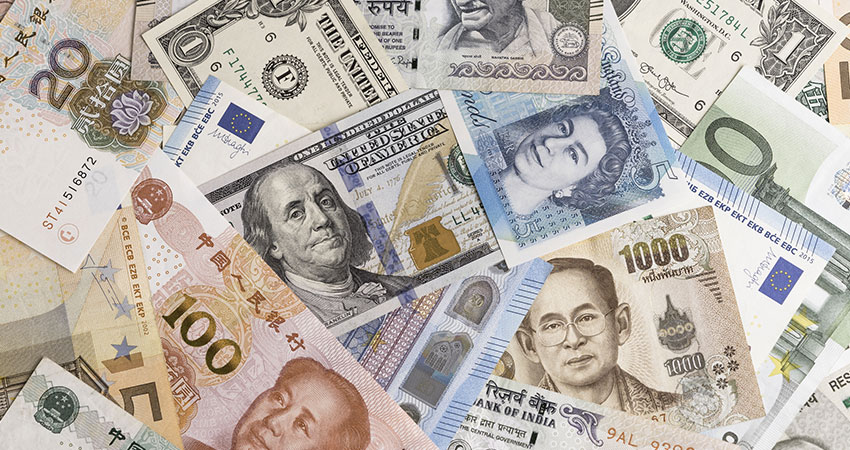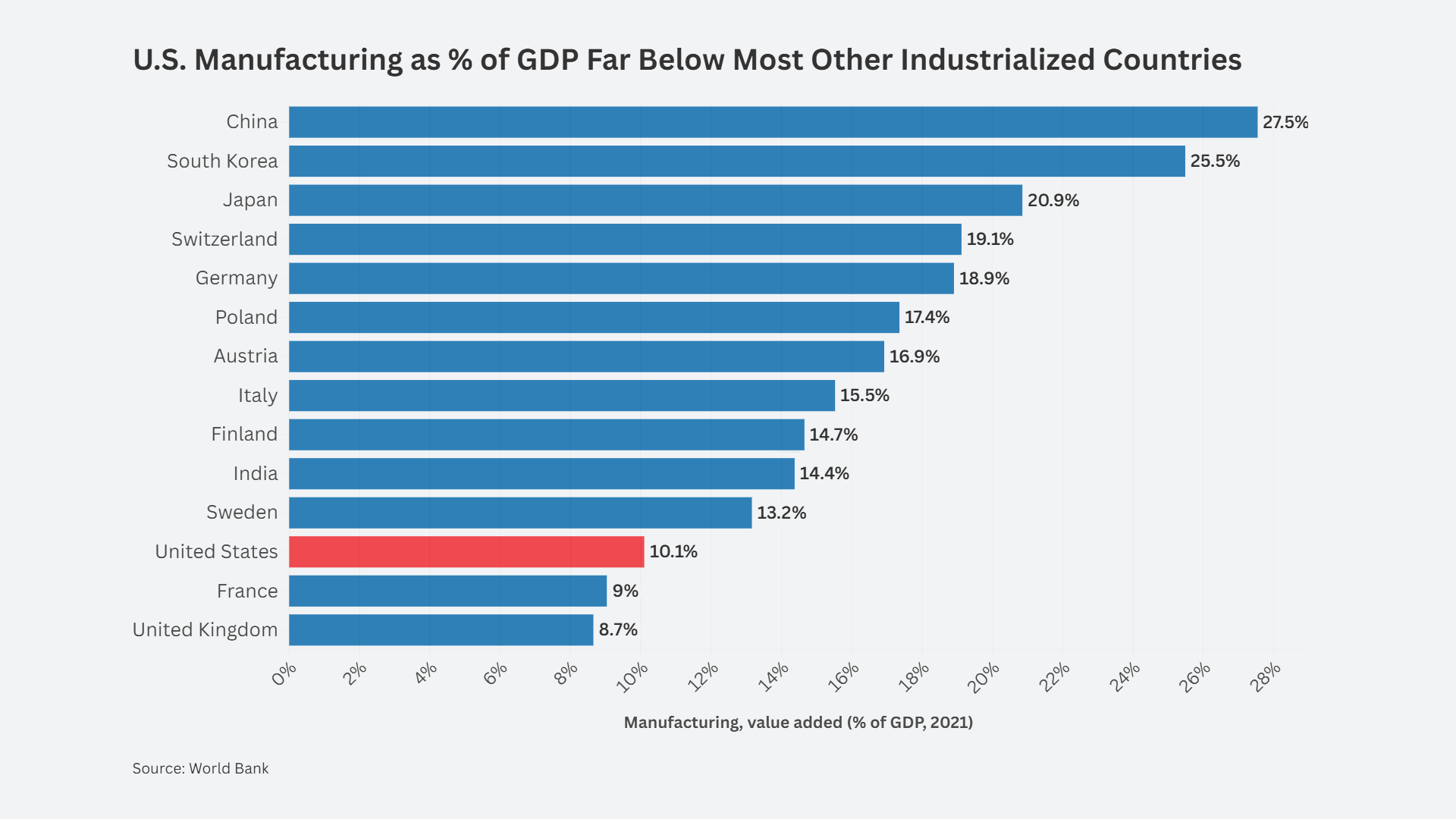- New monthly index tracks currency misalignment based on latest market rates
- Dollar is 11.2% overvalued
- Japanese yen 27.7% undervalued
- Chinese yuan 18.9% undervalued
- CMM is a partnership between the Coalition for a Prosperous America (CPA) and the Blue Collar Dollar Institute (BCDI).
Today we are launching our Currency Misalignment Monitor (CMM). The CMM uses the latest available data to estimate the level of overvaluation or undervaluation for the world’s major currencies. Fair valuation for a nation’s currency is a vital component of a nation’s competitive position. The U.S. dollar has been overvalued for almost all of the past 50 years, exerting negative pressure on U.S. industry and agriculture. The overvalued dollar has made many sectors of U.S. manufacturing uncompetitive. Meanwhile, other nations have allowed their currencies to remain undervalued, or have deliberately managed their currencies to achieve undervaluation, enabling them to run large trade and current account surpluses.
In economics, a currency is at fair value if it is neither accumulating foreign exchange nor losing foreign exchange. Large or persistent accumulation or loss of foreign exchange distorts economies’ ability to maintain balanced production and consumption. Surplus countries tend to overproduce and underconsume while deficit countries do the reverse. Further, persistent deficits create the risk of capital inflows suddenly stopping, with disastrous consequences, as we saw in the Asian currency crisis of 1997.
The current account is the broadest measure of inflows and outflows of foreign exchange, excluding flows of portfolio investment. The current account balance includes the balance on trade flows, investment income, and remittances by U.S. workers to foreign family or friends.
The Currency Misalignment Monitor is based on the latest data on current account balances from the International Monetary Fund and the latest market value of currencies from the Bank for International Settlements. The CMM minimizes excessive current account balances by calculating new exchange rates for 34 major currencies that will bring their current accounts close to balance, i.e. close to zero, over a five-year time horizon. (See Methodology section below for further details.)
Table 1 shows the latest results of the Monitor for ten of the most important currencies. The U.S. dollar is today 11.2% overvalued in comparison to its economic fair value. This figure represents overvaluation against a basket of currencies when all currencies are moving towards their equilibrium value. The dollar’s move is much larger against the currencies of persistent surplus nations. The CMM shows the Japanese yen undervalued by 27.7% and the Chinese yuan by 18.9%. For global equilibrium the yen should be at 102 to the dollar while the yuan should reach 5.71 to the dollar. South Korea and the Eurozone are also strongly undervalued, at 17.8% and 16.3% respectively.
Canada and Mexico are both projected to have significant deficits by 2027 (Canada had a small surplus last year) and so their currencies need to fall slightly against the basket of currencies. They are not far from fair value against the dollar in our Monitor. The United Kingdom had the second largest current account deficit (after the U.S.) last year and is projected to have the largest deficit in 2027. Its currency needs to fall significantly against the basket of currencies, but in our model only falls 2.8% against the dollar, to $1.25, because the dollar itself falls 11.2% against the basket.
IMF forecasts have a history of being over-optimistic. If China finds a way to maintain a larger surplus than the 0.4% forecasted by the IMF, then our estimate of an 18.9% revaluation against the dollar could be insufficient. If currencies other than the dollar were assumed to be fixed, then the dollar would need to move more than 11.2% to achieve a balanced U.S. current account in five years. A rough estimate would be that the dollar might need to move about twice as much, around 25%, to deliver balanced trade to the U.S.
In today’s world, where trillions of dollars of capital move across borders every year, major currencies (except for those managed by their government) are driven primarily by capital flows. The dollar has risen some 37% since 2011 in spite of persistent and growing deficits in the current account, trade account, and goods trade account. The dollar has been overvalued since the early 1980s but has moved in roughly ten-year cycles. The current rising cycle began in 2011 and is still with us 12 years later. A gentle decline in the dollar has been predicted by many financial analysts since the Treasury market crunch of March 2020, but that decline has so far failed to materialize.
Table 1. Currency valuations from Currency Misalignment Monitor, March 2023
| Currency Misalignment Monitor, March 2023 | |||||
| Currency | Over or Under | % Over/Under valuation | Latest rate | FEER-consistent dollar rate | |
| US | Dollar | Overvalued | -11.2% | 1.00 | 1.00 |
| China | Yuan | Undervalued | 18.9% | 6.80 | 5.71 |
| Japan | Yen | Undervalued | 27.7% | 131 | 102 |
| Korea | Won | Undervalued | 17.8% | 1246 | 1058 |
| Eurozone | Euro | Undervalued | 16.3% | 1.08 | 1.25 |
| UK | Pound | Overvalued | -1.3% | 1.22 | 1.20 |
| Mexico | Peso | Overvalued | -2.4% | 19.0 | 19.5 |
| Canada | C$ | Undervalued | 2.0% | 1.34 | 1.32 |
| India | Rupee | Undervalued | 4.6% | 81.9 | 78.2 |
| Brazil | Real | Overvalued | -7.7% | 5.21 | 5.64 |
| Notes: 1. % Over/Undervaluation is for each currency’s Real Effective Exchange Rate as compared to the basket of currencies. Red figures indicate overvaluation compared to basket. | |||||
| 2. FEER-consistent rate shows bilateral dollar exchange rate once each currency has moved to its Fundamental Equilibrium Exchange Rate. | |||||
| 3. Pound and Euro rates are expressed as dollars per those currencies. All others are currency per dollar. | |||||
METHODOLOGY
The Currency Misalignment Monitor is based on pioneering work done by William Cline at the Peterson Institute for International Economics. The Cline model, also known as SMIM for Symmetric Matrix Inversion Method, uses IMF forecasts for current account balances for 34 nations to derive a simultaneous solution for all exchange rates that will minimize national current account balances, including surpluses and deficits. The Monitor uses this methodology. However, the Cline version sets a target of plus or minus 3% of GDP for each nation’s current account. We believe this is too flexible for a properly functioning global trading system. Our model sets a target of 0% current account balance for each nation. Most nations do not achieve 0% in year five, but the model seeks to get them as close to zero as possible and in so doing gives us a realistic sense of each currency’s over or undervaluation.
Note also that this methodology is dependent on IMF forecasts, which currently run from 2022 data out to 2027. The IMF has a history of optimism, including for example expectations that the U.S. current account deficit and the China surplus will both contract over time. If those forecasts turn out to be over-optimistic, then the misalignment estimates in the Monitor could well be understated. Nevertheless the Cline SMIM model is an innovative method for incorporating a large amount of global data into a single model.
The Currency Misalignment Monitor (CMM) is published in partnership between the Coalition for a Prosperous America (CPA) and the Blue Collar Dollar Institute (BCDI).













